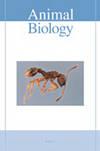鸟类和哺乳动物的血浆乳酸脱氢酶和丙酮酸激酶活性随体重和年龄的变化
IF 0.9
4区 生物学
Q2 ZOOLOGY
引用次数: 0
摘要
鸟类和哺乳动物通过线粒体氧化磷酸化产生大部分三磷酸腺苷(ATP),但当氧气不足时,ATP可以通过厌氧糖酵解产生。丙酮酸激酶(PK)催化糖酵解的最后一步,将磷酸烯醇丙酮酸和二磷酸腺苷(ADP)转化为丙酮酸和ATP。乳酸脱氢酶(LDH)通过催化丙酮酸转化为乳酸,在厌氧糖酵解中起重要作用。在这项研究中,我们测量了鸟类和哺乳动物血浆中的LDH和PK活性,以确定LDH和PK与体重和年龄之间的关系。结果表明,与哺乳动物相比,鸟类具有更高的LDH和PK活性。仅在鸟类中,体质量与血浆乳酸脱氢酶活性呈正相关。然而,当数据经过系统发育校正后,这种关系就消失了。在鸟类或哺乳动物中,我们没有观察到血浆乳酸脱氢酶与年龄之间的显著关系。血浆PK活性与鸟类体质量呈负相关,而与哺乳动物体质量无显著相关性,与年龄呈正相关。由于鸟类和哺乳动物的代谢差异,LDH和PK与体重和年龄之间的关系可能很复杂。鸟类LDH和PK活性随体重的增加可能与飞行的无氧需求有关,特别是在较大的鸟类中。哺乳动物LDH活性随年龄/最长寿命(MLSP)的降低可能反映了与鸟类相比不同的代谢变化。在哺乳动物和鸟类中,随着年龄的增长,PK的增加可能有助于它们应对细胞衰老时更大的能量需求。本文章由计算机程序翻译,如有差异,请以英文原文为准。
Plasma lactate dehydrogenase and pyruvate kinase activity changes with body mass and age across birds and mammals
Birds and mammals produce most adenosine triphosphate (ATP) through mitochondrial oxidative phosphorylation, but when oxygen is not present in sufficient levels, ATP can be produced through anaerobic glycolysis. Pyruvate kinase (PK) catalyzes the final step of glycolysis by converting phosphoenolpyruvate and adenosine diphosphate (ADP) into pyruvate and ATP. Lactate dehydrogenase (LDH) is important for anaerobic glycolysis by catalyzing the conversion of pyruvate into lactate. In this study, we measured LDH and PK activities in plasma from birds and mammals in order to determine the relationship between LDH and PK with respect to body mass and age. Our results show that birds had a higher LDH and PK activity compared with mammals. There is a positive relationship between body mass and plasma LDH activity in birds only. However, this relationship disappears when the data are phylogenetically corrected. We did not observe a significant relationship between plasma LDH and age in birds or mammals. Plasma PK activity was negatively correlated with body mass in birds but not in mammals and positively associated with age in both birds and mammals. The relationship between LDH and PK with respect to body mass and age may be complex due to differences in metabolism in birds and mammals. Increases in LDH and PK activity with body mass in birds may be linked to anaerobic demands of flight, especially in larger birds. A decrease in LDH activity with age/MLSP (maximum lifespan) in mammals may reflect a differing metabolic shift as compared with birds. Increases in PK with age in both mammals and birds may help them cope with greater energetic needs as cells age.
求助全文
通过发布文献求助,成功后即可免费获取论文全文。
去求助
来源期刊

Animal Biology
生物-动物学
CiteScore
2.10
自引率
0.00%
发文量
34
审稿时长
3 months
期刊介绍:
Animal Biology publishes high quality papers and focuses on integration of the various disciplines within the broad field of zoology. These disciplines include behaviour, developmental biology, ecology, endocrinology, evolutionary biology, genomics, morphology, neurobiology, physiology, systematics and theoretical biology. Purely descriptive papers will not be considered for publication.
Animal Biology is the official journal of the Royal Dutch Zoological Society since its foundation in 1872. The journal was initially called Archives Néerlandaises de Zoologie, which was changed in 1952 to Netherlands Journal of Zoology, the current name was established in 2003.
 求助内容:
求助内容: 应助结果提醒方式:
应助结果提醒方式:


